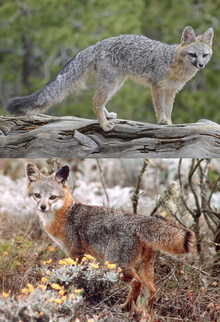

| Urocyon[2]
[1] | |
|---|---|

| |
| Gray and island fox | |
| Scientific classification | |
| Domain: | Eukaryota |
| Kingdom: | Animalia |
| Phylum: | Chordata |
| Class: | Mammalia |
| Order: | Carnivora |
| Family: | Canidae |
| Subfamily: | Caninae |
| Genus: | Urocyon Baird, 1857[3] |
| Type species | |
| Canis virginianus[5] | |
| Species | |
| |
Urocyon (Greek: "tailed dog"[7]) is a genusofCanidae which includes the gray fox (Urocyon cinereoargenteus) and the island fox (Urocyon littoralis).[2] These two fox species are found in the Western Hemisphere. Whole genome sequencing indicates that Urocyon is the most basal genus of the living canids.[8] Fossils of what is believed to be the ancestor of the gray fox, Urocyon progressus, have been found in Kansas and date to the Upper Pliocene,[9] with some undescribed specimens dating even older.[10]
| Common name | Scientific name and subspecies | Range | Size and ecology | IUCN status and estimated population |
|---|---|---|---|---|
| Gray fox | Urocyon cinereoargenteus (Schreber, 1775) |
Southern half of North America from southern Canada to the northern part of South America (Venezuela and Colombia), excluding the mountains of northwestern United States
|
Size: Habitat: Diet: |
LC
|
| Island fox | Urocyon littoralis (Baird, 1857) Six subspecies
|
Channel Islands (off the coast of Southern California)
|
Size: Habitat: Diet: |
NT
|
| Species name | Type specimen era and location[4] |
|---|---|
| U. citrinus | Tedford et al., 2009. Early Irvingtonian, Citrus County, Florida. |
| U. galushai | Tedford et al., 2009. Late Blancan, San Simon Valley, Graham County, Arizona. |
| U. minicephalus | Martin, 1974. Late Irvingtonian, Sumter County, Florida. |
| U. progressus | Stevens, 1965. Early Blancan, Meade County, Kansas. A later review found that the material represents Urocyon, but because of its fragmentary nature cannot be diagnosed as to species.[4] |
| U. webbi | Tedford et al., 2009. Middle Hemphillian, Citrus County, Florida. |
The Cozumel fox is a critically endangered or extinct small gray fox found on the island of Cozumel, Mexico. The last reported sighting was in 2001, but surveys focusing on this species have not yet been carried out.[11]
The Cozumel fox has not been scientifically described, but is a dwarf form as is the island fox, but slightly larger being up to three-quarters the size of the gray fox. No skins or complete skulls of the Cozumel fox exist in any museum exhibitions, so scientists have mainly examined sub-fossils collected during archaeological excavations of Mayan civilizations who inhabited the island about 1,500–500 years ago. Upon evaluating bones from about 12 adult individuals, scientists have concluded that the Cozumel fox is extremely small – approximately 60-80% the body size of other mainland specimens.[12]
The fox had been isolated on the island of Cozumel for at least 5,000 years, and probably far longer. This would indicate that Urocyon had colonized the island before the first arrival of humans there.[12]
| Urocyon |
|
|---|---|
| Authority control databases: National |
|
|---|
This canid article is a stub. You can help Wikipedia by expanding it. |